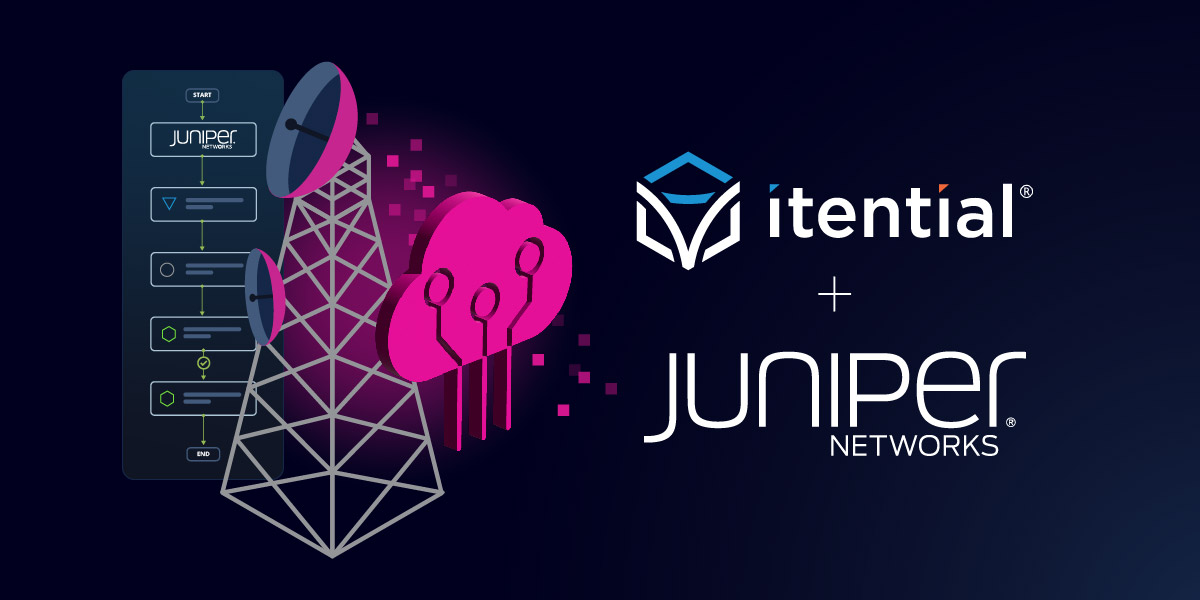This article was written in collaboration between Itential and Juniper to showcase how our solutions work together to help network teams rapidly and easily orchestrate infrastructure provisioning and management.
5G is a hot technology offering customers faster service, more bandwidth, and lower latency services over previous 3G and 4G technologies. These new services are in high demand and will enable a diverse range of products, opportunities, and most importantly revenue for service providers.
The technology and architecture that underpin these advanced 5G services necessitated deploying a greater number of base stations or cell sites and more edge data centers to host RAN network functions due to the smaller coverage areas, especially when compared to older legacy wireless technologies. Deploying new 5G services presents incredible opportunities for service providers if they can overcome challenges with deploying and configuring network infrastructure with greater efficiency, increasing time to value and delivering services faster than ever before.
Traditional Ways of Deploying 5G Infrastructure: Manual Effort & Service Delays
From the perspective of the network team, this requires provisioning additional edge data centers, as well as the deployment and management of a large fleet of Kubernetes clusters to orchestrate and manage cloud-native RAN functions (CNF) and ensure end-to-end network connectivity. The additional complexity introduced by Kubernetes also presents some challenges since most network engineers are not comfortable working with containers. By deploying 5G RAN applications on a smaller number of servers, typically 1 or 2 at each cell-site, and integrating cloud-native virtual cell site routers (vCSR) such as Juniper Cloud Network Router (JCNR) into the RAN DU server, the total cost of ownership can be reduced. Juniper Cloud-Native Router (JCNR) is a containerized router that combines Juniper’s proven routing technology with JUNOS Containerized Routing Daemon ( cRPD) as the controller and a high-performance Contrail DPDK-based vRouter data plane. It is implemented in Kubernetes and interacts seamlessly with a Kubernetes container network (CNI) framework. This approach also facilitates rapid deployment through automation, reduces the necessity for on-site visits, enhances the capability to deploy Cell Site Services, and simplifies the upgrade process.
Sounds great, but that means to guarantee a successful outcome, network architects and practitioners must reduce the time it takes to deploy and configure the underlying infrastructure that enables these customer services. Traditional methods of accomplishing this mean network teams follow a lengthy process that requires many manual steps for gathering data from systems, making changes to a multitude of network devices, documenting changes, and verifying the network state and the operation of the new service. This frequently leads to long lead times to provision new services, and ultimately a delay in revenue recognition of days, weeks, or even months.
So, the challenge becomes, “How does the network team deploy an increasing number of edge data centers, faster than ever before, without hiring new teams of people and training them up or overworking the current team?”
Itential + Juniper: The Right Orchestration Solution to Accelerate 5G Infrastructure Provisioning
These are challenges that every service provider in the 5G space will need to overcome. This can be accomplished quite elegantly with the combination of Juniper Networks’ 5G network solutions and Itential’s Automation and Orchestration platform working together to orchestrate changes across the underlay and overlay infrastructure and facilitate lightning-fast deployment of edge data centers at scale — all without increasing headcount — to keep up with customer demand.
“How does that work?”
By leveraging the Itential Automation Platform’s ability to integrate with the rich northbound automation APIs and interfaces exposed by Juniper JCNR, along with other network and internal systems and solutions, your current network team can build workflows that can orchestrate Day 0 through Day 2+ changes to 5G underlay and overlay, and even facilitate the provisioning of other cloud services in a low-code canvas that doesn’t require previous programming knowledge.
Itential’s workflow capabilities enable network teams to orchestrate, configure, and manage Day-0/1/2 configurations of JCNR vCSR instances across multiple locations, ensuring configuration consistency and eliminating errors. Beyond configuring the JCNR vCSR solution, Itential’s workflows can also automate a series of network pre-checks and post-checks to verify network state, validate management and control plane before and after changes to make sure that the newly provisioned services meet the SLA requirements for applications, and integrate with ticketing and documentation systems to provide consistent reporting of changes to relevant stakeholders.
For more details on how it all works together, watch this video that demonstrates how quickly you can deploy a new JCNR and update underlay, overlay, and provision 5G services from an Itential workflow.
The integration between Itential and Juniper can be used for many use cases. Whether you are deploying complex 5G services at scale, or provisioning and managing SD-WAN or Internet services, teams can orchestrate Juniper infrastructure more efficiently than ever before with Itential. Our partnership makes it easy to orchestrate processes and enable your organization to provide self-service infrastructure.
Helpful Documentation
Juniper Cloud Native Router References:
JCNR Blogs:
- Cloud-Native Routing in 5G Deployments
- Secure Virtual Cell Site Router Solution with JCNR and cSRX
- JCNR for Equinix Metal





